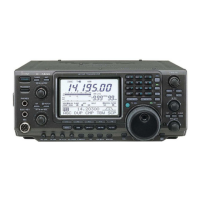78
10
DATA COMMUNICATION
■ Packet (AFSK) operation
Before operating packet (AFSK) be sure to consult the
operating manual that came with your TNC.
q Connect a TNC and PC. (p. 77)
w Push a band key to select an operating band.
e Push [SSB] or [AM/FM] to select the desired operat-
ing mode.
•After LSB or USB is selected, push [SSB] for 1 sec. to
select LSB data or USB data mode, or after AM or FM is
selected, push [AM/FM] for 1 sec. to select AM data or
FM data mode.
•Generally, LSB is used on HF bands and FM is used for
packet operation on the VHF band.
r Rotate the tuning dial to tune the desired signal.
t Transmit your AFSK signals using your computer’s
keyboard.
• Rotate [RF PWR] to set the output power.
•Relative strength of the transmitted signal is indicated in
the Po meter while operating the TNC.
•When operating in SSB (data) mode, adjust output
power so that the ALC reading in the ALC meter stays
in the ALC zone.
NOTE: When connecting a TNC to the ACC socket
on the rear panel, select SSB (LSB/USB) data mode
or disconnect the microphone and rotate [MIC
GAIN] fully counterclockwise.
When SSB data mode is selected, the audio input
from the [MIC] connector is automatically cut, and
the audio input from the [ACC(1)] is used.
Also, when the SSB data mode is selected, the fixed
setting listed below are selected automatically;
• Speech compressor : OFF
• Transmit bandwidth : MID
• Tx tone (Bass) : 0
• Tx tone (Treble) : 0
DD
Frequency indication during AFSK operation
When operating AFSK in SSB mode, the indicated fre-
quency is the signals carrier point.
Band keys[TX] indicator[TRANSMIT]
[MIC GAIN] [AM/FM] Tuning dial
Selected mode indicator appears
[SSB]
• Example— LSB/LSB data mode
Mark freq.: 2125 Hz
Shift freq.: 200 Hz
2325 Hz
200 Hz 2125 Hz
Carrier point
(Displayed frequency)
IC-7400.qxd 02.4.2 11:35 Page 78

